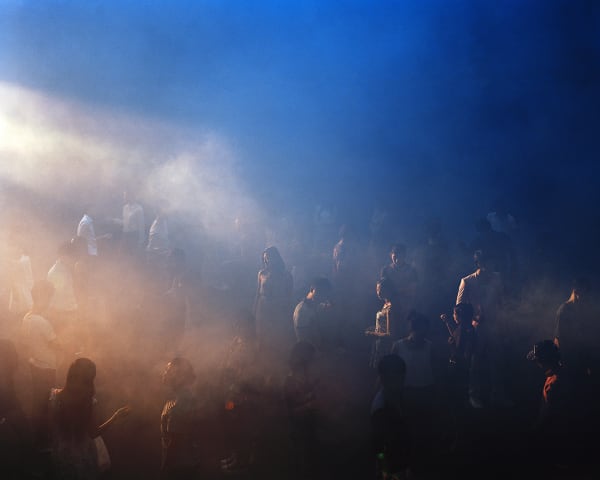Gallery Collection: Ay Tjoe Christine, Chen Wei, Uuriintuya Dagvasambuu, Monir Shahroudy Farmanfarmaian, Yayoi Kusama, Dennis Oppenheim, Wang Yahui, Saskia Olde Wolbers
Ota Fine Arts Shanghai is delighted to present Gallery Collection, a group exhibition featuring eight artists from across the globe: China, Indonesia, Japan, Mongolia, The Netherlands and U.S.A. These artists are of diverse backgrounds working in a variety of mediums - painting, photography, video and sculpture. Each of them have been important in creating new contexts in contemporary art.
Ay Tjoe Christine began her career as an artist that worked with the dry point technique. Later on, she transitioned from dry point on paper to painting with oil bar on canvas.
"I'm Free Without Identity #03" (2015) is a painting done with an oil bar. Bold strokes, colourful shapes, and a perfect balance between positive and negative space marks the painting. Despite the initial impression of chaos and disorder, a closer look at the work reveals that there are 'creatures' hidden amidst. Ay Tjoe believes that there is a dormant animalistic instinct in every human being and the potential to do both good and bad. These creatures are a manifestation of those beliefs. They are also her expression of the emotions that she has experienced as a human being, struggle, pain, melancholy, etc. Uuriintuya Dagvasambuu's takes on a more figurative approach in her painting "The World of No Words" (2011). The work is characterized by its innovative composition and inspired by traditional Mongolian design and recognizable motifs from East and Central Asian aesthetics. A vivid chrysanthemum flower is accompanied by a trailing vine of human faces and figures. In the backdrop, an accumulative pattern of white clouds is painted over a flat plane of deep blue.
Beijing based artist Chen Wei documents human desires and values through his photographs of empty interiors, carefully crafted models, and staged nightclub scenes. "In the Waves #5" (2013) shows a dreamy still image of young people that are intoxicated and dancing under the spotlights in a nightclub. Chen expressed that it reflects the reality of young people in China: that it brings them much relief and pleasure to be floating in the waves of society, but there is the lingering fear of being washed away. A pioneer of earthworks and conceptual art, Dennis Oppenheim, was known for incorporating engineer's stakes and plan drawings into his artwork. In "Contour Lines Scribed in Swamp Grass"(1968), he has combined photographs and satellite images of a land area in New Haven, Connecticut. These images reveal the changes occuring to a land mass over time either as a result of human intervention or of natural weather phenomena.
While Chen Wei and Dennis Oppenheim use photography to depict different types of reality, Wang Yahui uses the medium of photography to test the boundaries of visual perception. Viewers are lured into Wang Yahui's "A Slant of Light #2" (2015). Here, one is tempted to go beyond the darker foreground into the light-filled background beyond a translucent curtain. One's spacial perception of the empty and solid, inside and outside, positive and negative space will be put to the test and made to rethink their concept of space.
Monir Shahroudy Farmanfarmaian draws upon a sixteenth century Iranian decorative form known as ainehkari, when glass imported from Europe often arrived broken. She takes the ancient craft into the now and explores the art form in a contemporary context. "Toury" (2009) and "Hendacagon" (2008) is characterized by a merging of visual and spatial experience, pieces of broken mirror are assembled together to form carefully constructed shapes. As light gets reflected off the surface of the work, infinite geometric forms are revealed transforming the flat mirrored work into a threedimensional geometric experience. "Toury" in particular also includes elements of traditional Islamic architecture. In the center of the room is "RED FLOWER" (1980), a sculpture in dramatic red created with stuffed fabric work gloves by Yayoi Kusama. The flower motif has been a part of Kusama's work since the beginning and finds its root in her childhood where she would spend time wandering in her parent's nursery. Here, soft phalliclike biomorphic forms line the stem and head of the blooming flower reminding us of things found in the natural world and of Kusama's accumulative universe.
Saskia Olde Wolbers' video "Pareidolia" (2011) was shot inside model sets of a university lecture theatre, an archery hall and various traditional Japanese interiors. The liquid visuals in the video are analogue and handcrafted by dipping living forms, skeletal objects and architectural forms in paint or by submerging them underwater. As these materials and elements collide, the resulting image is one that oscillates between representation and abstraction. The narrative in the background is told from the point of view of a fictional translator between a Japanese archery master, his German apprentice, and the translator's alter ego, a bird.
This exhibition reveals the diversity and interconnections between the works of these 8 artists, in spite of their origin. Each of these artists has been crucial in creating new modes of working and a new context to understanding contemporary art today.






